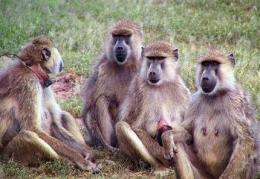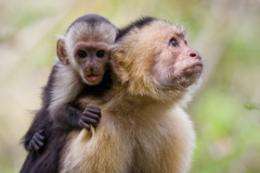Age affects us all

Humans aren't the only ones who grow old gracefully, says a new study of primate aging patterns. For a long time it was thought that humans, with our relatively long life spans and access to modern medicine, aged more slowly than other animals.
Early comparisons with rats, mice, and other short-lived creatures confirmed the hunch. But now, the first-ever multi-species comparison of human aging patterns with those in chimps, gorillas, and other primates suggests the pace of human aging may not be so unique after all.
The findings appear in the March 11 issue of Science.
You don't need to read obituaries or sell life insurance to know that death and disease become more common as we transition from middle to old age. But scientists studying creatures from mice to fruit flies long assumed the aging clock ticked more slowly for humans.
We had good reason to think human aging was unique, said co-author Anne Bronikowski of Iowa State University. For one, humans live longer than many animals. There are some exceptions - parrots, seabirds, clams and tortoises can all outlive us - but humans stand out as the longest-lived primates.
"Humans live for many more years past our reproductive prime," Bronikowski said. "If we were like other mammals, we would start dying fairly rapidly after we reach mid-life. But we don't," she explained.

"There's been this argument in the scientific literature for a long time that human aging was unique, but we didn't have data on aging in wild primates besides chimps until recently," said co-author Susan Alberts, Associate Director at the NSF-funded National Evolutionary Synthesis Center in Durham, NC, and a biologist at Duke University.
The researchers combined data from long-term studies of seven species of wild primates: capuchin monkeys from Costa Rica, muriqui monkeys from Brazil, baboons and blue monkeys from Kenya, chimpanzees from Tanzania, gorillas from Rwanda, and sifaka lemurs from Madagascar.
The team focused not on the inevitable decline in health or fertility that comes with advancing age, but rather on the risk of dying. When they compared human aging rates — measured as the rate at which mortality risk increases with age — to similar data for nearly 3,000 individual monkeys, apes, and lemurs, the human data fell neatly within the primate continuum.
"Human patterns are not strikingly different, even though wild primates experience sources of mortality from which humans may be protected," the authors wrote in a letter to Science.
The results also confirm a pattern observed in humans and elsewhere in the animal kingdom: as males age, they die sooner than their female counterparts. In primates, the mortality gap between males and females is narrowest for the species with the least amount of male-male aggression - a monkey called the muriqui - the researchers report.
"Muriquis are the only species in our sample in which males do not compete overtly with one another for access to mates," said co-author Karen Strier, an anthropologist at the University of Wisconsin who has studied muriquis since 1982. The results suggest the reason why males of other species die faster than females may be the stress and strain of competition, the authors say.
The accelerated rate of aging observed in male sifaka is noteworthy according to Diane Brockman, an anthropologist at the University of North Carolina at Charlotte who has been part of a 26-year sifaka lemur study. Sifaka exhibited the largest difference in male and female rates of aging of all the species in the study.
"Although male and female sifaka have equivalent body mass and exhibit similar rates of adult mortality, males age twice as fast as females for reasons that are unknown, but are likely due to the tendency of males to engage in risky behaviors, including intense competition for mates in the breeding season and group takeovers/infanticide in the birth season. Female sifaka, on the other hand, remain in their natal groups with maternal relatives most of their lives and thus are not as intensely competitive as males, although they are subject to the same extrinsic sources of mortality as males, including predation and falls from trees."
Brockman believes that the generality of the primate pattern of mortality and rates of aging observed in these wild primate populations demonstrates the value of these remarkable longitudinal studies for elucidating how humans fit into the broader primate continuum of aging, yielding a deeper understanding of our common evolutionary roots.
Do the findings have any practical implications for humans? Modern medicine is helping humans live longer than ever before, the researchers note. "Yet we still don't know what governs maximum life span," Alberts said. "Some human studies suggest we might be able to live a lot longer than we do now," she added. "Looking to other primates to understand where we are and aren't flexible in our aging will help answer that question."
More information: Bronikowski, A., J. Altmann, et al. (2011). "Aging in the natural world: comparative data reveal similar mortality patterns across primates." Science 331(6022). datadryad.org/handle/10255/dryad.8682
Provided by University of North Carolina at Charlotte

















